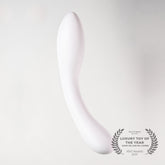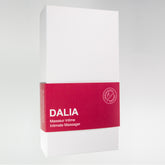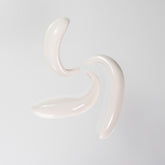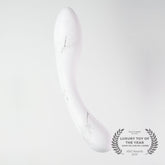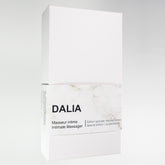Masturbation 101 (for people with vagina)
How have been your masturbation sessions lately: Out of this world? Same old? Satisfying? Non-existent? If the latter is your case (and if this is problematic for you), head to our blog post about Low sexual desire. If you are interested in enhancing your masturbation practice, learning new tricks or starting mindful masturbation, please keep reading!
A Word on the History of Masturbation
➡️ PSA: Masturbation does not cause acne, infertility, shrink your genitals, unwanted hair, mental illness or cancer nor will it damage your current or future sex life! So if you heard something like that, rest assured - these are myths - so enjoy masturbation.
Masturbation surely exists since prehistoric humans found out that stimulating their genitals felt good, but this activity has been highly demonized throughout history, especially female masturbation. This demonization can be traced back in texts dating 1712, where masturbation was described as nothing less than self-pollution (Onania: or, the heinous sin of self-pollution)! In 1916, Winfield Scott Hall, a teacher of physiology, published a book called Sexual Knowledge where he describes female masturbation as ‘’an act of self-abuse’’ and a ‘’destructive and loathsome habit’’. I mean, talk about shaming something so natural! Religion also has its important role to play into demonizing sexual pleasure throughout history. No one has sex outside of marriage and with any other purpose than making kids, right? And people having sex are maried, heterosexual and have the same ethnicity, right?
That being said, in recent years masturbation has been more accepted and self-pleasure is slightly more talked about in public spheres of life (think TV shows like Sex Education, the collaboration between Lily Allen and Womanizer or Cara Delvigne with Lora DiCarlo). We also believe sex education in schools could play a positive role, but is unfortunately still mainly focused on abstinence, ITS and risks of pregnancy and leave aside the concepts of pleasure, consent, orgasms, gender, etc.
Masturbation, what about it?
Masturbation is often taboo, shrouded in shame and something that you should not do, especially when it comes to female masturbation. So if you are feeling ashamed when touching yourself know that self-pleasure is a healthy practice! Books like Come as You Are from Emily Nagowski and Carnal Knowledge from Zoë Ligon, can help you navigate the world of personal sexuality.
For womxn and people with vaginas that do masturbate it is generally easier for them to reach orgasm when having partnered sex. Which makes sense! They know their body, what feels good and pleasurable, so it’s easier for them to guide their partner as to what to do.
So, what exactly is an orgasm? It’s basically the physical response that follows sexual arousal and stimulation. At the peak of sexual pleasure (called the plateau phase) there is an increase of blood flow in the pelvic area which generates muscle tension and congestion of tissue. The orgasm that follows consists of involuntary but coordinated rhythmic contraction of the pelvic muscles, uterus, vagina and anus and resulting in an intense feeling of pleasure.

As we said before, an orgasm should not be the absolute goal of a sexual intercourse, you can definitely be satisfied and feel pleasure without one. So don’t put unnecessary pressure on yourself to have an orgasm every time, you might end up feeling Performance Anxiety! That being said there is the phenomenon of Orgasm Gap that we would like to address a bit further.
➡️ Make sure to read our blog post about the Female Orgasm and its benefits to learn more!
Quick word on the Orgasm Gap
Okay folks, let’s talk about the orgasm gap! True, orgasms are not all that, but when it has been demonstrated statistically in a 2016 study that women in heterosexual relationships have likely less chance of reaching orgasm: 65% for women VS 95% for men, we believe it’s quite problematic. So, what can explain this vast gap?

First of all, for a long time sex when it came to women (in society’s mind) was a reproductive function and pleasure was not part of the bedroom equation at all.
Second, the fact that female pleasure is mostly disregarded or ignored. For example, Lauren Streicher writes in her book Sex R: ‘’we joke about boys masturbating, we joke, but it is accepted’’. But when it comes to girls it’s not talked about, discouraged and even shamed.
Third, the depiction of sexual relationships in media and porn usually over value male sexuality, rarely focuses on female or non-hetonormative pleasure. And almost every time, the two partners miraculously reach orgasm at the same time! With these types of images ingrained in our communal brain, it is no wonder women tend to fake orgasms more than men. They do it to make their partner happy (which is problematic in itself), to put an end to an intercourse she knows she won’t orgasm from, to make their partner come faster, to not feel like a failure, etc.
Fourth, lack of knowledge regarding the female anatomy and especially the clitoris! Knowing that most people with vaginas are having orgasms through clitoral stimulation, it is a wonder that it is not the majority of people who know where it is located, how to touch it and stimulate it.
Fifth, women often learn from a very young age (from their upbringing, movies, tv shows, etc.) to be nice, to please, to not disturb peace, to be quiet, etc. Asking for what they want in bed often comes with a feeling of uneasiness for a lot of women who were not thought to advocate for themself and speak up.
Masturbation 101
To maximize sexual pleasure you need to understand what feels good for you, what your body responds to, what erogenous zones turn you on, etc. That’s where masturbation comes into play! It can allow you to connect to your sexuality, your sexual response and to gain confidence in yourself. It is also a good way to relax, to feel good and even to reduce menstrual pain! Solo masturbation is a great way to become aware of your body, to claim it and to take care of yourself. Mutual masturbation, aka partnered masturbation, is a fun way to switch things up in bed, built up heat and arousal with someone. It can also replace penetration if you are currently living with painful intercourses.
📝 Guidelines
There isn’t truly a step-by-step recipe for masturbation, if what you are doing feels good, keep going. You can keep these guidelines in mind though:
- Don’t hurry up to finish the job
- Don’t focus solely on orgasm, your masturbation session should focus one pleasure first and foremost
- Don’t forget about non-genetalia erogenous zones such as the nipples, inner thighs, neck, butt cheeks, etc.
- Switch things up from time to time: change position, change location (shower, bathtub, couch), add lube, add a sex toy, etc.
Clitoral Massage
Most peaople with vulvas can achieve orgasm through clitoral stimulation!
‘’According to a 2015 internet-based survey published in the Journal of Sex & Marital Therapy, which received responses from over 1,000 U.S. women, 36 percent reported that clitoral stimulation helped them orgasm during intercourse, whereas slightly more than 18 percent reported they orgasmed from intercourse alone.’’ (NBC)

➡️ So here are a few things to try during your clitoral masturbation:
- Rubbing
- Stroking
- Indirect massage (for example the skin around the clitoris)
- Varying the pressure
- Adding a sex toy
- Try out temperature play (easier to do with a sex toy)
- Use water or lube
- Rub your perineum
- Use your fingers to penetrate your vagina
- Try different positions (laying on your back, on your knees, standing up, etc.)
- Do it while reading or listening to erotica
- Watch yourself in the mirror
Everyone is different, so make sure to test different things out and to learn what you like!
G-spot orgasm
The much debated G-spot was discovered in the 50s by the gynecologist Ernst Grafenberg (hence the name G-spot). It is only recently (2009) that scientists realized that this spot is actually an internal portion of the clitoris. This extremely sensitive erogenous zone in the female anatomy can bring new sensations of pleasure and deeply intense orgasms. Located in the area in front of the vagina, the location and size of the G-spot varies for each person, hence the importance of exploration.
👉 Keep in mind that the G-spot is difficult to find for three main reasons: it is not located at the same height for everyone, varies in size and is easier to find when engorged with blood (when you’re excited). We recommend that you first try tactile exploration because you can identify it by its rough and bumpy texture. Some people describe it as a “nut” on the vagina’s walls. You can then try to stimulate it with your fingers or a toy (like the Dalia). To reach the G-spot area you can aim at the navel. Some researchers compare this area to a clock and would locate it between the eleventh and the first hour.
When you find and stimulate it, you are actually pressing the key location to deform the clitoris and thus create an optimal stimulation. So start with a light pressure at first and build it up to what you prefer. You can explore your g-spot area by yourself first as it will be easier to guide your partner afterwards. Remember g-spot is pressure sensitive not touch sensitive!


Mindful masturbation
Did you hear about mindful masturbation? It’s having quite the momentum nowadays! To put it simply, it's self-stimulation (so masturbation) where you make a conscious effort to experience pleasure specific to your body. Which is generally different from the usual masturbation session you default to. So it’s important to be present physically and mentally and to not judge yourself!
The aim with mindful masturbation is to put pleasure at the center of the sexual experience rather than the orgasm. The same could be said with the concept of slow sex. Removing the pressure that often comes with the absolute desire to reach orgasm will generally lead to a more pleasurable experience and more intense sensations. Because this means you will not rush things nor try to default to your usual patterns (moving a certain way, using a certain position or toy, thinking about a specific fantasy, etc.)
Sounds a bit complicated? It really isn’t that fancy, the point is mostly to slow things down and try new things!
📝 But here are some tips to get you started:
- It is helpful to schedule (in your mind or literal agenda) a mindful masturbation session. So you make sure no one’s home to disturb you, there are no upcoming calls or engagements, etc.
- Set the mood: use candles, dim the lights, put on sensual music
- When you feel like you are reaching orgasm, stop, and build up again. Delay the orgasm as much as you can
- Explore your body and touch new erogenous zones
- Use organic lube
- Focus on pleasure instead of orgasm
- Use audio erotica to help increase arousal if needed
- Use your other hand to stay away from your usual patterns
- Focus on how you touch yourself, make slight variations in the movement or pressure
- Remember how you usually breathe during masturbation (and orgasm) and try to change it. For example slow it down, take deep breaths instead of short quick ones, try to be very quiet, etc.
Finally, if you want to go the extra mile, a little journaling afterwards is a good idea to keep track of what you tried, how it made you feel and how you are feeling after your mindful masturbation session.
Have fun!
👀 Are you properly washing your vulva and vagina? Click here for our blog post on myths and best practices!
Sources:
Sex Rx: Hormones, Health, and your best sex ever by Lauren Streicher, MD
Sex Again: Recharging your libido by Jill Blakeway, LAc
nbcnews.com/better/lifestyle/orgasm-gap-why-it-exists-what-women-can-do-about-ncna983311
https://www.thegoodtrade.com/features/self-pleasure-mindfulness
https://www.insider.com/talking-about-female-sexuality-and-orgasm-gap-in-lockdown-2020-5
https://www.shape.com/lifestyle/sex-and-love/how-to-mindful-masturbation
https://passionbykait.com/secrets-of-mindful-masturbation/


